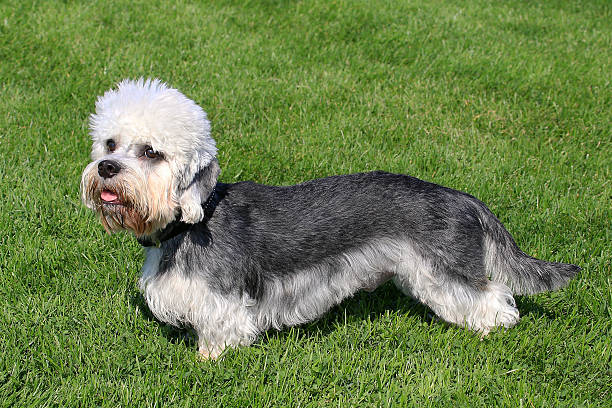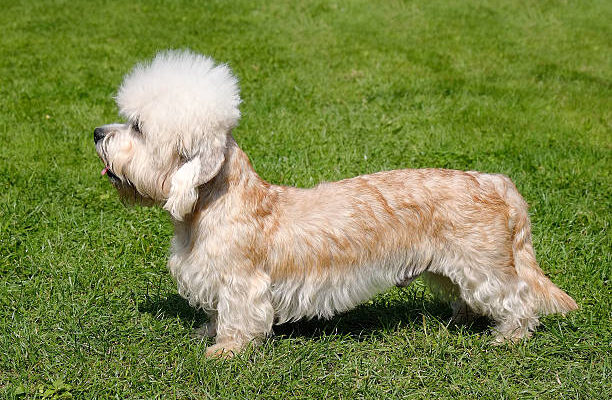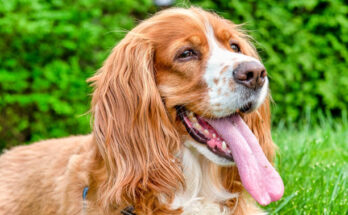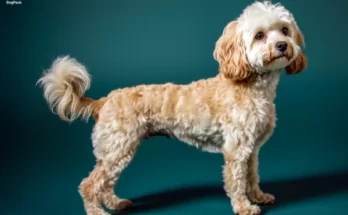The Dandie Dinmont Terrier achieves a big impact within the dog world even though its physical stature remains tiny. The terrier group contains the Dandie Dinmont Terrier because of its unique top-knot hair combined with its characteristic long, low body shape. An insightful article provides in-depth analysis of the Dandie Dinmont Terrier’s whole life by reviewing its historical roots and physical makeup alongside training information and grooming practice, and suitable habitat requirements.
Table of Contents
- Introduction to Dandie Dinmont Terriers
- History and Origin
- Physical Characteristics
- Personality and Temperament
- Training a Dandie Dinmont Terrier
- Exercise and Activity Needs
- Nutritional Requirements and Diet
- Grooming and Hygiene
- Common Health Issues and Preventive Care
- Socialization and Behavior
- Living Conditions and Adaptability
- Fun Activities and Games
- Conclusion
Introduction to Dandie Dinmont Terriers
Traditional Dandie Dinmont Terriers feature a compact body shape while displaying strong characteristics, along with their characteristic silky topknot and cylindrical body form. The dignified behavior of Dandies stands apart from typical terriers, though they carry terrier characteristics as proof of their courage and spirit. As hunters of vermin, their independence gained from their training persists along with their strong loyalty toward people they like. The Dandie Dinmont Terrier stands as an ideal choice for families desiring a brasshearted companion that remains peacefully reserved.
The Dandie Dinmont exhibits distinctiveness from all terriers concerning its physical structure and personality attributes. The dog breed demonstrates historic charm and a DNA composition that defies typical expectations.
History and Origin
Roots in the Scottish Borders
History records the Dandie Dinmont Terrier rising in the border areas connecting Scotland with England starting during the early 1700s. Farming communities together with gypsies used the terriers to pursue badgers and otters but demanded dogs that brought personal intelligence and had the nerve to search underneath soil.
Literary Fame
The literary history of the Dandie Dinmont Terrier differentiates it from all other dog breeds. Dandie Dinmont Terriers get their name from a fantasy character in the 1815 literary work Guy Mannering by author Sir Walter Scott. A pack of unique terriers belonged to the fictional character, thus his name continued to be used.
Breed Development
Dandie Dinmont terrier development took place during the nineteenth century, with both looks and traits targeted for improvement. The Kennel Club in the UK granted official recognition status to the breed during the late 1800s. Although modern times have decreased their numbers, the Dandie Dinmont Terrier continues to be valued as a family pet by terrier breed fans across the globe.
Fun Fact: You will find the Dandie Dinmont Terrier to be the singular dog breed with its pedigree linked to a made-up character.
Physical Characteristics
Size and Build
- Height: 8–11 inches
- Weight: 18–24 pounds
- Build: Long-bodied and low to the ground, with short but powerful legs
Dandie Dinmonts have a unique silhouette with a domed skull and muscular frame. Their physical form is suited for working underground while still being agile and playful.
Coat and Colors
- Coat Texture: Soft, dense undercoat with a crisp, wiry topcoat
- Topknot: Silky hair on the head, softer than the rest of the body
- Recognized Colors:
- Pepper (bluish-black to silver-gray)
- Mustard (reddish-brown to pale fawn)
The non-shedding coat of a Dandie Dinmont Terrier appeals to allergy-sensitive owners but does require detailed grooming.
Personality and Temperament

What Is the Dandie Dinmont Like?
Although friendly by nature Dandies display contained terrier personality traits through brief periods of energetic behavior. Their devotion focuses on family members, while they enjoy hugging their loved ones while keeping watch over their home. Through their disposition, they display graceful charm together with smart thinking abilities and a little bit of steadfastness.
Are Dandie Dinmont Terriers Good Family Dogs?
Yes. These dogs show tenderness toward all family members, but they show their most loving nature when interacting with older child companions. Family bonds form naturally because of their emotional nature, which matches perfectly with quiet indoor environments. Breeding dogs requires proper socialization during the first stages of life to establish a harmonious household environment.
Are Dandies Good Guard Dogs?
Absolutely. Dandies will notify their owner about foreign persons without becoming excessively vocal. Owners frequently discover the deep bark and alert stance of Dandies to be uncharacteristic of their tiny body frame.
Training a Dandie Dinmont Terrier
Intelligence and Trainability
Dandies possess exceptional intelligence, together with a dose of self-reliance. Such dogs benefit from dedicated patient training using steady, consistent guidance. Heavy-handed approaches should never be used because Dandies possess such sensitive dog characteristics.
Basic Training Tips:
The training process should begin early, as you teach obedience skills combined with exposing your dog to meet new people.
Reward your Dandie Dinmont Terrier through treats while also praising the dog and spending time playing with objects.
Short and enjoyable training sessions help prevent mental apathy among the family members.
Senior citizens should introduce family rules at the beginning, followed by strict enforcement of these guidelines.
Socialization
The exposure of your Dandie Dinmont Terrier to various people, together with different animals and diverse environments throughout their puppy stage, helps prevent fear-based reactions. Dandies receive suitable socialization to become properly mannered with other canines, along with being welcoming toward people who enter their home.
Exercise and Activity Needs
Daily Exercise Requirements
Dandie Dinmont Terriers maintain good mental and physical health with moderately active exercise performed each day. Your Dandie Dinmont Terrier requires time periods between 30 to 45 minutes a day for optimum health.
Activity Ideas:
- Walks in the neighborhood
- Light fetch in the yard
- Indoor play sessions
- Controlled off-leash time in secure areas
Mental Stimulation
Physical activities need equal importance to mental stimulation for dogs. Dandies demonstrate their love for solving puzzles along with their need for fresh activities in life.
Ideas for Mental Engagement:
- Puzzle feeders
- Hide-and-seek with toys
- Basic obedience and trick training
- Scent work using hidden treats
Nutritional Requirements and Diet
Recommended Diet
Small, moderately active breeds need a nutritional diet that achieves dietary harmony. Either kibble from high-quality sources or raw-fed diets can fulfill nutritional needs when owners follow their vet’s dietary advice.
Ideal Foods:
- Lean proteins like turkey, chicken, and fish
- Brown rice, sweet potato, and oatmeal
- Veggies like green beans and carrots
- Small portions of fruit (e.g., apple slices or blueberries)
Feeding Schedule
- Puppies: 3 small meals per day
- Adults: 2 evenly spaced meals per day
Excessive food portions lead to obesity in these dogs, which they should avoid. Fresh water consumption must be available to your Dandie Dinmont at all times, along with the restriction of rich table foods and human foods.
Grooming and Hygiene
Grooming Routine
The coat of Dandie Dinmonts stays neat when owners perform a regular grooming routine to stop mat formation and uphold their distinctive appearance.
Grooming Essentials:
- Brushing: 2–3 times weekly
- Bathing: Every 4–6 weeks
- Professional Hand-Stripping or Trimming: Every 6–8 weeks
- Nail Trimming: Every 2–3 weeks
- Ear Cleaning: Weekly
- Dental Care: Brush teeth 2–3 times per week
Coat Maintenance by Age
- Puppies: Introduce grooming tools early
- Adults: Regular trimming and coat care are necessary
- Seniors: Maintain a consistent grooming schedule to avoid skin problems
Common Health Issues and Preventive Care
Common Health Conditions
The Dandie Dinmont Terrier experiences overall good health, although owners need to watch for particular health issues related to the breed.
- Intervertebral Disc Disease (IVDD): Due to their long back
- Glaucoma: A potentially serious eye condition
- Hypothyroidism: Can cause weight gain and lethargy
- Epilepsy: Rare, but reported in some lines
Preventive Care:
- Annual veterinary wellness exams
- Regular eye and spine screenings
- Maintain a healthy weight to protect the back
- Consistent parasite control and vaccination schedule
Early detection is key to managing genetic health risks in Dandie Dinmont Terriers.
Socialization and Behavior
Tips for Socializing Your Dandie Dinmont:
- Introduce new people and pets gradually
- Use calm praise and treats during positive interactions
- Enroll in puppy kindergarten classes
- Continue socialization throughout adulthood
Common Behavioral Traits
- Loyal: Forms strong attachments to owners
- Courageous: Stands firm despite size
- Independent: Prefers autonomy but listens with trust
- Quiet: Not prone to unnecessary barking
- Adaptable: Handles change and new settings well
Living Conditions and Adaptability
Best Living Environments
The Dandie Dinmont dog accepts many residential settings, including urban flats alongside expansive country dwellings. Their major requirements include company and regular exercise instead of unlimited space.
Suitable Homes:
- City apartments with daily walks
- Suburban homes with fenced yards
- Countryside homes where they can roam under supervision
Climate Sensitivity
- Cold Weather: Tolerates cold reasonably well with a thick coat
- Hot Weather: Should avoid long exposure—offer shade and hydration
Fun Activities and Games
Physical and Mental Games
Interactive games that match their energetic yet thoughtful disposition bring the most joy to Dandies.
Game Ideas:
- Short games of fetch indoors or outdoors
- Hide-and-seek using treats or toys
- Tug-of-war for bonding and strength
- Obstacle courses designed for small dogs
Enrichment Tools
- Treat-dispensing puzzle toys
- Lick mats for calming focus
- Snuffle mats to encourage nose work
- Interactive obedience training apps
A variety of games helps prevent boredom and keeps your Dandie happy.
Conclusion
The Dandie Dinmont Terrier stands as a precious treasure among dogs because this unique breed possesses enchanting features, and noble personality, and unwavering devotion. The Dandie Dinmont’s moderate size, together with their pleasant character, serves as an excellent relationship choice for any person who plans to support their grooming requirements and exercise needs.
Key Takeaways:
The Dandie Dinmont Terrier exhibits four main characteristics, including dignified behavior, together with intelligence and love.
A proper grooming routine remains vital since this dog breed possesses wiry fur combined with a silk topknot.
A mix of reasonable exercise together with active mental engagement helps keep your dog mentally stable.
Early socialization fosters confidence and friendliness
The Dandie Dinmont Terrier forms a lifelong bond with its family, which produces deep, affectionate friendships.
People who want a splendid companion along with a wise nature and elegant qualities will find great value in learning about Dandie Dinmont Terriers.




